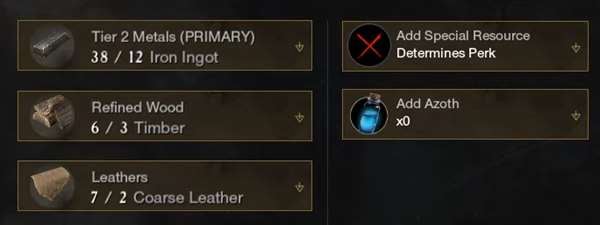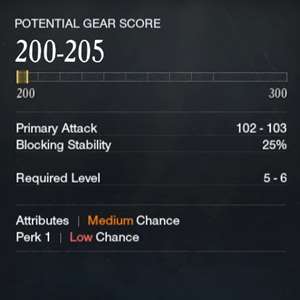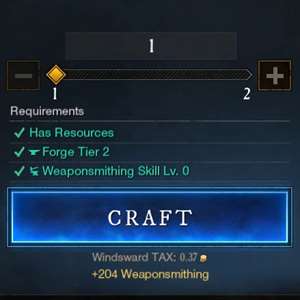Armoring |
|
|---|---|
| Allows for the crafting of Armor equipped in the head, chest, hands, legs and feet slots. Armorers can also craft Storage Bags to increase the player's inventory space. |
|
| Trade Skill Tree | Crafting |
| Type Perk | Armor |
| Recipes Type | Head Armor Chest Armor Hand Armor Leg Armor Foot Armor Storage Bags |
Armoring is a Crafting Trade Skill in New World. Armoring allows for the crafting of Armor equipped in the head, chest, hands, legs and feet slots. Armorers can also craft Storage Bags to increase the player's inventory space. Trade Skills are a variety of non-combat skills that the player can invest in and master. Trade Skills belonging to the Crafting category focus on creating a large variety of items ranging from Weapons and Consumables to ammunition and furniture.
New World Armoring Information
Armoring is the Crafting skill focused on creating Armor by using resources and materials obtained from skills in the Gathering and Refining lines. A higher level in Armoring will allow players to create better, more powerful Armors, as well as improving the Gear Score range of craftable weapons.
Armoring can be performed at a Forge or Outfitting Station, depending on the type of armor and these stations can often be found in Settlements. Crafting stations have a Tier level which can be increased by taking on Town Projects. Note that each Armor piece has a tier level requirement in order to craft. This tier level corresponds to the crafting station's tier level. If your settlement's Forge or Outfitting Station level does not meet the requirement, you will need to either raise it or find another settlement with a station of a higher tier. Crafting Armor requires the player to be of the appropriate Armoring level as well. Leveling up in Armoring is a straightforward process. Players simply need to continuously craft armor raise their level in the skill. Collecting resources, however, is more involved and can prove more difficult.
Armoring Related Skills
Armoring is a skill that relies heavily on the following skills for resources and materials and as such, they are strongly recommended companion skills:
Note that materials for any Crafting skill can be obtained from other players as well by trading, so players can still be successful in Armoring even if they invest in other skills, but this requires playing the game's economy system.
Armoring Armor Perks
While Crafting a piece of Armor, it has a small chance of gaining one or more Perks or an Empty Gem Socket. While these outcomes are random, players can use the special resource Azoth during the crafting process to improve the chances of getting perks, a socket or both. Additionally, there are a number of special materials that can be gathered in the world that, when used during the crafting process, can dictate what Perk is added to the armor. However, there are still no guarantees that a Perk or Gem Socket will indeed be added to the piece of equipment but the chance increases as the Crafting skill level increases.
Check the Perks page for a full list of possible armor perks and the resources needed to imbue them onto crafted weapons.
New World Armoring Guide
Navigation
The Armoring crafting process begins by interacting with a Forge or Outfitting Station which are crafting stations found in Settlements. The Forge is used for the crafting of Heavy armor types while the Outfitting Station is used to craft Light and Medium Armor, as well as Storage Bags. Within the crafting UI, you can see all your learned recipes on the left panel for all Crafting skills associated with the crafting station. Selecting a recipe displays the item and its required materials in the middle panel while displaying a preview of the potential result on the right.
Recipe Panel
Displayed in the left panel are all available crafting recipes. Items displayed in White indicate that you meet all the requirements to craft the item. Items displayed in Red indicate that you do not meet one or more of the crafting requirements (Resources, Skill Level, etc.). The small icon to the right of each item displays the crafting skill used and the numerical value represents the minimum level required in the skill in order to craft the item.

Materials Panel
The materials panel in the middle displays the required materials in order to craft the item. Each crafted item requires one type of Primary material and at least one or more types of Secondary materials. In addition, crafters can add a Special Resource to predetermine the first Perk that will be added onto the item. Azoth can also be added to increase the chances of adding an Attribute, Perk or Gem Slot.

Primary Materials
Primary Materials are comprised of the main refined material used in a given crafting recipe. For example, melee weapons crafted by Weaponsmithing will predominantly be composed of metals such as iron or starmetal. A primary material's tier will always correspond to the crafted item's tier. Lower tier primary materials cannot be used to craft items of a higher tier.
Secondary Materials
Unlike Primary Materials, Secondary Materials used in a crafting recipe can be of any tier within the same category. For example, the Weaponsmithing recipe for the Starmetal Great Axe calls for Refined Wood as one of the secondary materials. The crafter can use any of the following to fulfill the requirement: Timber, Lumber, Wyrdwood Planks, Ironwood Planks, Petrified Wood, Glittering Ebony, Whisperwood, Quillbark, Ebonwood, Wildwood, Barbvine or Animal Horn. In the case of Secondary Materials, using a material of a higher Tier such as Ironwood Planks will raise the resulting item's Minimum Gearscore. Meanwhile, using a material of a higher Rarity such as Barbvine can raise both the Minimum and Maximum Gearscore. Using better materials in combination with raising your crafting skill level is the key to creating the most powerful equipment and items.
Note that certain items such as named or unique Weapons and Armor will have set material requirements that cannot be altered. However, these items usually provide much better or unique bonuses to counteract this lack of flexibility.
When crafting items, it is important to note that the crafting station will draw from your pool of resources in both your Inventory as well as any Storage Sheds you possess within the Settlement so it is not necessary to clog up your inventory with crafting materials if you have a storage shed in the current settlement. Note that Storage Sheds are not shared between Settlements. Items you have in storage in Windsward cannot be used for crafting in First Light, for example. However, you can transfer items between storage sheds from the storage menu.
Special Resources and Azoth
Crafted items have a chance to gain one or more Perks during the crafting process. However, the Perks added are completely random and the chances any are added at all are rather low until you get to higher levels of crafting. Even then, the chances are not guaranteed.
Special Resources such as Chunk of Sparkmetal can be added during the crafting process to predetermine one of the added Perks. Note that this still does not guarantee that the chosen Perk is added at all. In order to raise the chances of a crafted item gaining a Perk, players can add Azoth during the crafting process. Azoth can be added in increments of 15, up to a maximum of 75. In general, the more Azoth you spend, the higher the chances of getting Perks. However, lower tier items will have a lower max threshold for Azoth infusion.
Results Panel

The Results Panel displays various information regarding the resulting item. The most relevant info here is the Potential Gear Score and the Potential Perks. This preview updates as you modify your material choices.

The bottom half of the Results Panel displays a slider indicating how many of the items you wish to craft with the current settings and is useful for mass crafting sessions. This section also lists the requirements which show up in Green if you meet them and in Red if you do not. At the very bottom, the Tax for the current crafting session is displayed. This tax will vary depending on what the Settlement's Governor has set for crafting in this territory. Also displayed is the amount of Skill XP gained from the crafting session. When ready, click the Craft button to create your item.
Gear Score & Item Yield
Leveling up in Armoring improves your crafted equipment's Minimum and Maximum Gear Score by tiers. Improving the Maximum Gear Score allows for the potential for better items while improving the Minimum Gear Score shortens the Gear Score range, making it easier to craft items at the higher end. Item Yield is not affected by leveling in Armoring.
Tier II Armor
The Maximum Gear Score for Tier II Crafted Armor improves in increments of 5 for every 5 levels, up to a maximum of 75 at level 70.
Starting at level 40, the Minimum Gear Score for Tier II Crafted Armor improves in increments of 5 for every 10 levels, up to a maximum of 20 at level 70.
Tier III Armor
Starting at level 50, the Maximum Gear Score for Tier III Crafted Armor improves in increments of 5 for every 5 levels, up to a maximum of 75 at level 120.
Starting at level 90, the Minimum Gear Score for Tier III Crafted Armor improves in increments of 5 for every 10 levels, up to a maximum of 20 at level 120.
Tier IV Armor
Starting at level 100, the Maximum Gear Score for Tier IV Crafted Armor improves in increments of 5 for every 5 levels, up to a maximum of 75 at level 170.
Starting at level 140, the Minimum Gear Score for Tier IV Crafted Armor improves in increments of 5 for every 10 levels, up to a maximum of 20 at level 170.
Tier V Armor
The Maximum Gear Score for Tier V Crafted Armor improves in increments of 5 at levels 150, 165, 180, 190 and finally maxing out at 25 at level 200.
The Minimum Gear Score for Tier V Crafted Armor cannot be improved by leveling.
New World Armoring Leveling Tips
Leveling up in Armoring allows for crafting of better, more powerful Armor with higher Gear Scores and also improves chances of imbuing them with Perks or a Gem Socket. Leveling up in Armoring unlocks more recipes as well as more powerful versions of existing recipes.
As a general rule, sticking to lower tier items is the recommended method for quickly leveling up a Crafting Skill. This is due to the cost of crafting items increasing exponentially as you move up in tiers, with some higher level recipes costing up to double the amount of resources to craft. Another reason to craft lower tier items for leveling is the ease of gathering resources and the relative low market cost should you choose to purchase them instead.
In the case of Armoring, the most efficient items to craft in terms of Materials to XP ratio are the Weak Oakflesh Balm (Tier II) consumables. Unfortunately, these items are locked behind Level 20 Armoring. To reach this threshold, you will be crafting Tier II Gloves which offer the next best Material to XP Ratio. For Armoring, you have a choice between Light, Medium and Heavy armor. Each type of Armor uses a primary material, between Cloth, Leather and Metals and the other two as secondaries. For example Light Armor uses Cloth as primary materials, with Leather and Metals as secondaries.
It's important to note that each crafted item can be salvaged to get some of the primary materials back. This is useful for cutting on material gathering by crafting Tier II items from the Light, Medium and Heavy categories and salvaging them for a small return on each material type which can then be used as secondary materials for Tier III and above if you choose to go that path.
The following table details the amount of experience required to reach certain levels in Armoring, as well as a general count for the amount of Crafted Items required to reach these thresholds. For simplicity's sake, the table only shows tier milestone levels instead of every single Armoring level.
New World Armoring Leveling Chart
| Level | Required Experience | Crafted Items |
|---|---|---|
| Level 0 - 50 (Tier II) | Phase 1: 2,950 XP Phase 2: 8,175 XP |
Phase 1: 28 x Linen Gloves / Coarse Leather Gloves / Iron Plate Gauntlets Phase 2: 228 x Weak Oakflesh Balm |
| Level 50 - 100 (Tier III) | 86,250 XP | Glove Route: 799 x Linen Gloves / Coarse Leather Gloves / Iron Plate Gauntlets Oakflesh Balm Route: 2,396 x Weak Oakflesh Balm |
| Level 100 - 150 (Tier IV) | 404,550 XP | Glove Route: 3,746 x Linen Gloves / Coarse Leather Gloves / Iron Plate Gauntlets Oakflesh Balm Route: 11,238 x Weak Oakflesh Balm |
| Level 150 - 200 (Tier V) | 1,379,500 XP | Glove Route: 12,774 x Linen Gloves / Coarse Leather Gloves / Iron Plate Gauntlets Oakflesh Balm Route: 38,320 x Weak Oakflesh Balm |
Leveling up Armoring in New World will require the use of an Outfitting Station of sufficient Tier (i.e., Tier IV Outfitting Station to craft Tier IV items) for Light and Medium gear and a Forge for Heavy gear. You will also want to have Harvesting at 30 in order to harvest magical plants for motes which should be easy to achieve as you gather materials for Light armor.
Level 0 - 50
Phase 1: Begin by getting your Armoring to Level 20. At this tier, you will want to gather as much Fibers, Rawhide and Iron Ore as you can. Do not worry about overgathering because these materials will be used as secondaries for Tier III and above, or should you choose to stick to this Tier of crafted items, you will need to stockpile a massive amount of them. All three materials are found in abundance in all of the starting areas but for efficiency, do all your gathering in either Monarch's Bluffs or Windsward where you will come across a lot of Earthspine and Rivercress plants from which you can gather Earth Motes and Water Motes respectively. Fibers are derived from the Hemp plant which are abundant around grassy areas. Rawhide can be harvested from practically any wildlife creatures around the starting zones and Iron Ore can be mined from Iron Veins found around highland areas.
You can choose between Light, Medium or Heavy Armor as they all use the same materials, albeit in varying amounts. It is recommended you craft an even split between the three, as each Armor type can be salvaged and you can retrieve a small portion of their primary materials. Salvaging Light Armor will refund a portion of Linen, Medium will refund a portion of Coarse Leather and Heavy will refund a portion of Iron Ingots. The materials required are as follows:
Linen Gloves (28 Total) To Level 20
- 112 x Linen: Comprised of 448 x Fibers
- 112 x Coarse Leather: Comprisd of 448 x Rawhide
- 28 x Iron Ingot: Comprised of 112 x Iron Ore
Coarse Leather Gloves (28 Total) To Level 20
- 112 x Coarse Leather: Comprised of 448 x Rawhide
- 112 x Linen: Comprised of 448 x Fibers
- 28 x Iron Ingot: Comprised of 112 x Iron Ore
Iron Plate Gauntlets (28 Total) to Level 20
- 112 x Iron Ingot: Comprised of 448 x Iron Ore
- 112 x Coarse Leather: Comprised of 448 x Rawhide
- 28 x Linen: Comprised of 112 x Fibers
Phase 2: Once you reach Armoring Level 20, you can begin crafting Weak Oakflesh Balm all the way to 50. As stated above, you can find the required Motes around Monarch's Bluffs and Windsward. Makes sure your Harvesting is at Level 30. Otherwise, take a few minutes to get it to the appropriate level. Alternatively, if you have Mining at 50, you can also gather these Motes from Earthcrag and Springstone nodes. Oil is derived from Seeping Stones which can be found frrequently in Monarch's Bluffs as well. These nodes require a Mining level of 20. The Northwest portion of First Light is also a good farming zone for Oil.
Weak Oakflesh Balm (228 Total) To Level 50
- 228 x Earth Mote
- 228 x Water Mote
- 228 x Oil
Level 50 - 200
For the remaining leveling brackets, you can stick to Tier II Gloves at 108 XP per craft or the Weak Oakflesh Balm at 36 XP per craft. It simply comes down to which you'd rather gather materials for. Of course, a mix of both routes is also viable, especially if farming in Monarch's Bluffs or Windsward where all required materials can be found in abundance.
Glove Route (~17,318 gloves total from Level 50 to 200)
While crafting Tier III Gloves and above technically yields more XP per craft, obtaining the primary materials require Refining Materials such as Crossweave, Tannin and Sand Flux which can only be acquired from Supply Boxes so they may be difficult to farm. It will also take a ton more work just gathering and refining the materials required. Remember to salvage your crafted items every now and then to cut down on gathering time.
- 69,272 x Linen: Comprised of 277,088 x Fibers
- 69,272 x Coarse Leather: Comprised of 277,088 x Rawhide
- 17,318 x Iron Ingot: Comprised of 69,272 x Iron Ore
- 69,272 x Coarse Leather: Comprised of 277,088 x Rawhide
- 69,272 x Linen: Comprised of 277,088 x Fibers
- 17,318 x Iron Ingot: Comprised of 69,272 x Iron Ore
- 69,272 x Iron Ingot: Comprised of 277,088 x Iron Ore
- 69,272 x Coarse Leather: Comprised of 277,088 x Rawhide
- 17,318 x Linen: Comprised of 69,272 x Fibers
At 108 XP per craft, this equates to ~1,870,344 XP which should get you to Level 200.
Oakflesh Balm Route (~51,953 Total balms from Level 50 to 200)
In the case of Oakflesh Balms, higher tier balms will technically provide more XP per craft, but fusing the higher tier wisps and essences required is an overall loss in Material to XP ratio, especially since there is no other way to acquire them.
For reference, a Weak Oakflesh Balm uses 1 x Earth Mote, 1 x Water Mote and 1 x Oil yielding 36 XP. A Common Oakflesh Balm uses 1 x Earth Wisp (5 Motes), 1 x Water Wisp (5 Motes) and 1 x Oil at only 90 XP per craft whereas those 5 Earth and Water Motes could be used to create 5 Weak Oakflesh Balms for 180 XP. This is the same for all higher tiers of Oakflesh Balm so you are better off sticking to Tier II Balms. Furthermore, mote fusions are locked behind levels 25, 75 and 125 Arcana setting up another prerequisite that doesn't exist for Tier II.
- 51,953 x Earth Mote
- 51,953 x Water Mote
- 51,953 x Oil
At 36 XP per craft, this equates to ~ 1,870,308 XP which should get you to Level 200.
Making Money from Armoring
If you are regularly doing Faction Missions and amassing Faction Tokens, crafting and selling Storage Bags can be very lucrative. Storage bags are always going to be in high demand as there is plenty of value in inventory space and carrying weight. The Coarse Leather Bag and Rugged Leather Bag require relatively easy-to-get materials plus a Minor Rune of Holding and Major Rune of Holding, respectively. The minor rune can be purchased for 1,000 Faction Tokens and 250 Coin while the Major Rune of Holding costs 3,000 Faction Tokens and 500 Coin. Both can be purchased from your Faction vendor. Both bags can sell for much more than the Coin investment and even more if they come with good Perks so make sure to use Azoth during the crafting process.
Armoring Recipes
Below you can find a list of Armoring Recipes grouped by Armor type you can follow to craft different Armor.
Please visit our Recipes page for more information.
Light Head Armor
You can search by Name, Tier, Forge Tier, or Ingredients. Just type into the search box what you are looking for.
Quick Search of All Recipes
The table is also sortable! Click on the header to sort it as you see fit.Medium Head Armor
Heavy Head Armor
Faction Head Armor
Light Chest Armor
You can search by Name, Tier, Forge Tier, or Ingredients. Just type into the search box what you are looking for.
Quick Search of All Recipes
The table is also sortable! Click on the header to sort it as you see fit.Medium Chest Armor
Heavy Chest Armor
Faction Chest Armor
Light Hand Armor
You can search by Name, Tier, Forge Tier, or Ingredients. Just type into the search box what you are looking for.
Quick Search of All Recipes
The table is also sortable! Click on the header to sort it as you see fit.Medium Hand Armor
Heavy Hand Armor
Faction Hand Armor
Light Leg Armor
You can search by Name, Tier, Forge Tier, or Ingredients. Just type into the search box what you are looking for.
Quick Search of All Recipes
The table is also sortable! Click on the header to sort it as you see fit.Medium Leg Armor
Heavy Leg Armor
Faction Leg Armor
Light Foot Armor
You can search by Name, Tier, Forge Tier, or Ingredients. Just type into the search box what you are looking for.
Quick Search of All Recipes
The table is also sortable! Click on the header to sort it as you see fit.Medium Foot Armor
Heavy Foot Armor
Faction Foot Armor
Storage Bags
You can search by Name, Tier, Forge Tier, or Ingredients. Just type into the search box what you are looking for.
Quick Search of All Recipes
The table is also sortable! Click on the header to sort it as you see fit.Armoring Consumables & Infusions
You can search by Name, Tier, Forge Tier, or Ingredients. Just type into the search box what you are looking for.
Quick Search of All Recipes
The table is also sortable! Click on the header to sort it as you see fit.
Armoring Notes and Tips
- ???
 Anonymous
AnonymousCan we have the armoring xp table and thanks for the huge efforts

 Anonymous
Anonymous

lol, I love watching all the derps wander around at EVERY hemp spawn location fighting for hemp, I'd also like to see all the muppets actually harvest the quarter of a million fibers y'all need to craft to 200... derpa herpa derp.
0
+13
-1